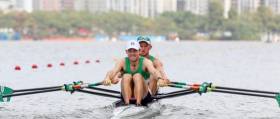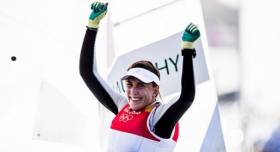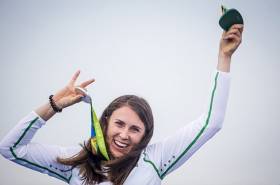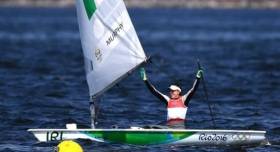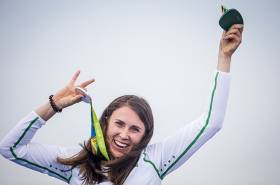Displaying items by tag: Rio 2016
Inside the Games has reported that World Sailing’s deficit for 2020 was lower than expected — and that it expects a similar dividend from the 2020 Olympic Games in Tokyo to what it received five years ago from Rio 2016.
Sailing’s world governing body says the “successful delivery” of Tokyo 2020 this summer after a year’s delay enforced by the COVID-19 pandemic had “alleviated the critical financial risks associated with the cancellation of the Games”.
The body’s accounts also included confirmation of an arrangements to borrow $3.1 million (€2.7 million) from the IOC, repayable without interest over five years from this December.
Inside the Games has much more on the story HERE.
Olympic Silver Medallist Annalise Murphy Is Irish Sailor Of The Year 2016 (Updated with Photo Gallery)
#SailorOfTheYear – Olympic hero Annalise Murphy has been named Afloat Irish Sailor of the Year for 2016.
August’s Sailor of the Month for her silver medal victory at Rio 2016 was presented with her prize by Irish Sailing Association (ISA) president David Lovegrove at the Volvo Irish Sailing Awards gala in Dublin’s RDS Concert Hall this evening (Friday 27 January).
Murphy was saluted by more than 300 of her fellow sailors, one of Irish sailing’s largest ever turnouts, for her Olympic triumph in the Laser Radial class – Ireland’s best achievement in sailing at the Games since David Wilkins and James Wilkinson won the Flying Dutchman silver at Moscow 1980.
That the National Yacht Club stalwart rallied from her heartbreak at London 2012, where she just barely missed out on a bronze medal, with an incredible display on the waters of Guanabara Bay made her success all the sweeter.
As Afloat.ie’s WM Nixon wrote in November, Murphy’s Olympic performance came after a 10-week transformation on the heels of a poor showing at the 2016 Worlds in Mexico:
“With her dedicated support team, she ensured that she’d become a hugely improved sailor, a fitter athlete and psychologically in a very good place, as she took on the Olympic challenge on August 8th with a cool confidence which in due course received its proper reward.”
It was an achievement that rightly captured the public’s imagination, too, providing Irish sailing with the greatest mainstream profile it’s enjoyed in years.
It’s already seen her recognised as The Irish Times/Sports Council of Ireland Sportswoman of the Year, Irish Tatler’s Woman of the Year, the Evening Echo’s Sports Star of the Year, and as one of Rehab’s two Sportspersons of the Year, not to mention her honorary membership of the Irish Sailing Foundation.
So it was surely to be expected that ‘Our Annalise’ would capture the public vote on Afloat.ie, as well as the votes of the judging panel to earn the prestigious award for a second time upon its 20th anniversary – two decades after first honouring that year’s own Olympic dinghy hero Mark Little, and four years on from her first win in recognition for her stellar efforts in London.
Accepting her prize, Annalise Murphy said: “As a kid I learned that maybe I wasn't the most talented, but I worked the hardest and that’s how I handled my sailing at the Olympics, and that’s what I’d advise all sailors to do now.”
Adding that the standing ovation from the ISA “means a lot to me”, she noted that it was “great to see all the Irish sailing achievements here, and that’s what I love in our great sport. It’s not all about the racing.”
Racing is still very much on Annalise’s agenda, however, with the first stage of her Tokyo 2020 campaign set for the Laser Radial Worlds this August.
Annalise’s accolade must also be seen in light of her fellow deserving nominees, all winners of Afloat.ie’s Sailor of the Month awards, and all of whom made remarkable and significant contributions to Irish sailing throughout the year.
Among them are a GP14 world champion in Shane MacCarthy, a Round Ireland record by Damian Foxall, a pioneering Vendée Globe effort by Enda O’Coineen, and youth sailor and future Olympic medal prospect Finn Lynch.
Irish sailing’s next generation was recognised in its own right on the night with the presentation of the Youth Sailor of the Year prize to Afloat’s racing Sailor of the Month for July, Ewan McMahon, alongside the Training Centre of the Year gong that this year went to Foynes Yacht Club, and two ISA President’s Awards – to Scottish Series racer Colin Moore, and Annalise Murphy's coach Rory Fitzpatrick, the latter of whom said of his eventful year: “It’s not just the Olympic result, it’s the inspiration of Annalise’s discipline routine in Dun Laoghaire that drives on our Laser sailors.”
In his address earlier this evening, ISA president David Lovegrove said he was “bowled over by the achievements of our sailors both at home and abroad.
“For such a small country, we achieve great things and our sailors are truly inspirational ambassadors for our sports and our country. 2016 was a year to make us all proud.”
But Lovegrove also took time to “celebrate the everyday heroes in sailing who don’t always get recognised by awards and cups – the volunteers who dedicate so much time, energy and passion to our sport, and who share their knowledge and expertise with other sailors.
“From the race officials to the instructors, to the coaches and the mark layers, the safety crews and those who carry out a multitude of tasks onshore: we simply could not enjoy sailing the way we do without you. Thank you.”
Hosted by master of ceremonies Fiona Bolger, chief executive of Spinal Injuries Ireland, along with Lovegrove and Afloat.ie’s own WM Nixon, the evening welcomed guests including members of the ISA Olympic and youth sailing squads, training centre principal, national senior and youth champions, class captains and club commodores, and a number of past Olympians and Sailors of the Year.
Great night @Irish_Sailing #Volvosailingawards celebrating our win with Irish Sailor of the Year @Annalise_Murphy pic.twitter.com/ePsrX1QUTy
— Clontarf Y&BC (@TarfYBC) January 27, 2017
Among the crowd were the Royal Cork's Sally O’Leary and her husband Anthony, 2010's Sailor of the Year, who are looking forward to the club’s dinghy fest, along with a band of club mates including Gavin Deane, Admiral John Roche and Rear Admiral Kieran O'Connell and Tom Durcan, who has just welcomed home his son Johnny from Australia, and Ted Crosbie who recently retired from racing.
Brian O’Sullivan and Francis Clifford represented Tralee Bay Sailing Club in the audience this evening, while Paddy Boyd, who was returned from a stint as CEO of Sail Canada, was also present, as were Chris and Sandra Moore of the Dublin Bay Sailing Club, Peter Ryan of ISORA, ICRA Commodore Simon McGibney from Foynes Yacht Club, and Martin McCarthy of Annalise’s home club, the National YC in Dun Laoghaire.
Others in attendance included Cormac Devlin, Cathaoirleach of Dun Laoghaire-Rathdown County Council, and Sport Ireland chief executive John Treacy.
O’Donovan Brothers Are RTÉ’s Sport Team Of 2016
#Rowing - Paul and Gary O’Donovan were last night named Team of the Year at the RTÉ Sport Awards, as RTÉ News reports.
The Olympic silver medallists in the lightweight double sculls in Rio this summer captured the hearts of the nation with their light-hearted post-race interview and subsequent appearance on The Late Late Show with fellow Olympic hero Annalise Murphy.
And just like Murphy, who added The Irish Times/Sports Council of Ireland Sportswoman of the Year award to her long list of accolades on Friday (16 December), the Skibbereen rowing brothers (and Afloat.ie Rowers of the Month for August) show no signs of resting on their laurels.
"We’re young yet, we’re only starting out hopefully," said Paul on the night. "We’ve got a taste of success now, so we’re going to capitalise on it."
Indeed, his brother Gary was back in the boat just hours before the awards ceremony for the Ireland Assessment at the National Rowing Centre — Paul only missing out due to Christmas exams.
Annalise Is Sportswoman Of The Year
#Annalise - 2016 draws to a close with another accolade for Ireland’s Olympic hero Annalise Murphy, who was named The Irish Times/Sports Council of Ireland's Sportswoman of the Year in Dublin this afternoon.
The Laser Radial silver medallist was Sportswoman of the Month for August, the same month of that outstanding achievement for Irish sport in Rio de Janeiro.
And that’s not counting her Sailor of the Month nod from Afloat.ie in August, as well as Irish Tatler’s Woman of the Year gong last month, her honorary membership of the Irish Sailing Foundation, the Sports Star of the Year Honour at last night's Echo Sports Awards, and a share of Rehab’s Sportsperson of the Year Award.
The last one she couldn’t accept in person as she enjoyed a well-earned break, dabbling in her ‘hobby’ of Moth sailing at competition level in Bermuda.
That dedication to her craft — which included a 24-hour whirlwind round trip to bring home her medal-winning dinghy — is what we’ve come to expect from our Annalise over the years.
And this latest award shows how the rest of Ireland’s sporting world is catching on. Well done, Annalise!
More from David O'Brien in the Irish Times HERE
Annalise Brings Home Olympic Medal-Winning Laser Dinghy
#Annalise - After a whirlwind 24-hour round trip by ferry and road to Britain this week, Annalise Murphy has returned to Ireland with the boat she sailed to a silver medal at this summer’s Olympic Games in Rio.
The idea of taking ownership of the historic Laser Radial dinghy was first mooted by our own WM Nixon back in August, and quickly gathered pace as Jim Cusask talked up the notion for the Irish Independent.
Here’s hoping Annalise and team have plans to let the public get a closer look at the dinghy she raced to success on Guanabara Bay at Rio 2016.
A 24hr round trip to @LaserPerform to pick up my boat from the Olympics! @Irish_Ferries got me safely home at 6am this morning! pic.twitter.com/WIH8iTFyBE
— Annalise Murphy (@Annalise_Murphy) November 29, 2016
Irish Sailing Foundation Honours Olympic Hero Annalise Murphy
#ISF - Rio silver medallist Annalise Murphy is now an honorary member of the Irish Sailing Foundation (ISF) following her incredible Olympic success this past summer.
The announcement comes as the ISF, the new investment support structure for Ireland’s high performance sailing programme, celebrates a year of achievement at every level of competition.
Indeed, Murphy’s medal win wasn’t the only result for Irish sailing in August, with fellow Team IRL members Ryan Seaton and Matt McGovern making their medal race in a final hurrah before their recent split, Andrea Brewster and Saskia Tidey just missing out on their skiff final, and Finn Lynch putting in a strong performance as the youngest in his class in preparation for a medal challenge at Tokyo 2020.
Beyond the Olympics, August was a good month for Johnny Durcan, Fionn Conway and Ronan Walsh, who took second, third and fourth places respectively in the UK Laser Nationals, while Johnny’s twin Harry Durcan, with Harry Whittaker, won the UK 29er Nationals in Torbay, and Tom Higgins sailed the first Irish boat to win the Volvo Gill Optimist National.
Earlier in the summer, there was success for Ireland’s girls in the Topper Worlds at Ballyholme, as Sophie Crosbie, Ella Hemeryck and Jenna McCarlie claimed the podium from gold to silver in that order, though the boys didn’t fare too badly either, with Michael Carroll in fourth and Jack Fahy sixth.
Elsewhere, at the Laser Worlds in Dublin, Nicole Hemeryck — sister of Ella — placed seventh in the U19 girls competition, while Ewan McMahon was second among the boys. Nicole was also second in the under 19s( 13th overall) at the under 21 worlds in Kiel, Germany.
And even earlier in the year, there was a bronze medal for Dougie Elmes and Colin O'Sullivan at the ISAF 420 Youth Worlds in Malaysia, the first ever podium for Ireland in that competition.
Currently all development teams in the Laser, Laser Radial and 49er have moved to Cadiz to escape the cold ahead of January’s annual World Cup in Miami, with further training camps to follow in Spain and Malta in February and March.
But the year isn’t over yet, as Ireland will be represented by Nicole Hemeryck and Johnny Durcan at the Youth Worlds in New Zealand from 14-20 December.
Looking at the longer term, ISA performance director James O’Callaghan will be on hand at a Performance Pathway information meeting at the Royal Cork this Wednesday 30 November where he will discuss, among other things, the results of his recent fact-finding mission to Tokyo.
O’Callaghan was gathering intel on the sailing venue at Enoshima with a view to Team IRL establishing an early base there — identified as one of the keys to Annalise’s medal finish this summer. That will be especially important at Tokyo 2020, where temperatures and humidity will be significantly higher than they were in Rio.
Annalise Murphy Is Irish Tatler’s Woman Of The Year
#AnnaliseMurphy - Congratulations once again to Annalise Murphy who was named Irish Tatler Woman of the Year at the magazine’s annual awards in Dublin last weekend, as Evoke.ie reports.
The prize is yet another appropriate tribute to the 26-year-old Laser Radial sailor’s convincing silver-winning performance at this summer’s Olympic Games in Rio.
But the National YC sailor was humble about the honour on Twitter, saying that it was “amazing to be in a room of so many inspirational women”.
Murphy was named Afloat.ie’s Sailor of the Month for August in recognition of her world-beating success on Guanabara Bay, four years after her heartbreak in London.
More Accolades As Silver Medalist Murphy Returns To The Water
#AnnaliseMurphy - Barely a month after her silver medal victory at the Rio Olympics and Annalise Murphy, The Irish Times' Sportswoman of the Month for August, is already back on the water.
This time, however, it was the foiling Moth she describes as her hobby compared to the "day job" of the Laser Radial she sailed to a podium finish in Rio's Guanabara Bay on 16 August.
Murphy – who was also named Afloat.ie's Sailor of the Month for August – tells Mary Hannigan how she still wakes up feeling like her incredible achievement was a dream - though her newfound fame has certainly changed her everyday life as fans approach with their congratulations.
The Irish Times has more on the story HERE.
Murphy's Victory Boosting The Profile Of Irish Sailing Says ISA Performance Chief
#ISA - Annalise Murphy's success in Rio is bringing the sport of sailing to "a much wider platform", according to the Irish Sailing Association's performance director.
Speaking to Bobby Kerr on Newstalk's Down to Business yesterday morning (Saturday 3 September), James O'Callaghan remarked on the sheer number of people of all ages who turned out for the Laser Radial silver medallist's homecoming in Dun Laoghaire.
"That's the first big change: all of a sudden we have a sports star," he said of Murphy, who was a guest on Friday's Late Late Show.
But beyond the media profile was talk of the business of getting her to sailing's elite level – thanks in great part to investment from Sport Ireland, investment that's focused on the sailing classes where Ireland can be most competitive.
O'Callaghan said taxpayer support is "exactly what's needed for Ireland to succeed on the international stage. But it's limited; the sport budget hasn't grown in the last four years."
As a result, private sponsorship – both of the ISA's programmes and individual sailors – remains a linchpin of the sport's funding, while the new Irish Sailing Foundation aims to attract the backing of philanthropists with a passion for Irish sporting success.
Listen to the whole interview below:
Annalise Murphy Talks 'Rollercoaster' Years Before Olympic Medal Win on The Late Late Show
#AnnaliseMurphy - Annalise Murphy has spoken of how the sting of missing out on a medal at London 2012 haunted her over the years of preparations for the Rio Olympics this summer – till she decided to make sailing fun again.
The Laser Radial silver medallist was a guest on last night's Late Late Show on RTÉ One – now available to watch on demand on the RTÉ Player – where she opened up to host Ryan Tubridy about the pressure her experience in Weymouth put her under.
"That medal race in London, it's kind of haunted me for the last four years," she said. "I always had this sort of voice in the back of my head, thinking maybe that was my moment and I messed it up.
"Olympic medals, they're really hard to come by, and I thought, maybe I wasn't going to get a medal in Rio, and that was going to be as good as it was going to get."
Murphy described her training in the intervening four years as a "rollercoaster", in particular last year's test event at the Rio sailing course, intended to see what shape she was in for this summer's games, where she placed last in the first day's races.
"The harder I tried, the 'more last' I would come," she said. "I nearly had to see the funny side of it, [because] I'd trained so hard and it just wasn't working out for me."
Murphy said the turning point was when she realised "I haven't been having fun, I need to start enjoying this again."
As a result, she regained her confidence "and in the last couple of months leading into the Olympics, I really felt like I was having good form and everything might start to work out my way."
Murphy credits her coach Rory Fitzpatrick, sports psychologist Kate Kirby and training partner Sara Winther with establishing a routine during the daunting week of racing in Rio, and keeping her "always in a really good frame of mind, just really enjoying it. Not getting stressed out, when I think of how some of the other competitors were."
But into the final medal race, she says she "suddenly had the fear of 'Oh no, I'm going to finish fourth again, this is going to be terrible.'"
Getting out on the water, the windy conditions gave a boost to the erstwhile 'Queen of the Breeze'.
However, when things got a bit too gusty, and Murphy suffered a number of capsizes, the race was postponed and she recalls: "At that stage I just wanted it to be done.
"I went into that [rescheduled medal] race thinking 'If I'm afraid ... I'm going to lose out.' I went in with zero fear. I was just like, 'You have to go and attack this race and see what happens.'"
It wasn't till she was in second place around the last windward mark, alongside Great Britain's Alison Young, and knowing both were far ahead of their closest rivals, that she realised a silver medal was hers at the very least.
"For it all to suddenly come together at the right time, it was just this feeling of relief," she said.
"Now I can look back and go, 'That was a really good fourth place in London.'"
Earlier in the evening, rowing silver medallists at Rio – and Afloat.ie rowers of the month for May 2015 – Paul and Gary O'Donovan shared their own story with Tubridy from the Late Late Show couch, which is also available on the RTÉ Player till 2 October.




























